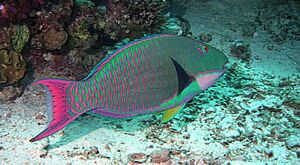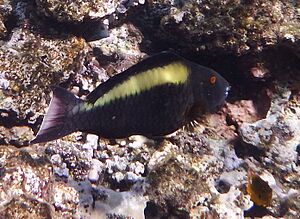Bicolour parrotfish facts for kids
Quick facts for kids Bicolour parrotfish |
|
|---|---|
 |
|
 |
|
| Terminal phase above, initial phase below | |
| Conservation status | |
| Scientific classification | |
| Synonyms | |
|
The bicolour parrotfish, also known as the bumphead parrotfish, is a colorful fish. Its scientific name is Cetoscarus bicolor. This amazing fish belongs to the Scaridae family, which are known for their strong, parrot-like beaks. You can only find this special fish in the Red Sea.
Contents
Where Does the Bicolour Parrotfish Live?
The bicolour parrotfish lives only in the Red Sea. This sea is located between Africa and Asia. It is known for its warm waters and amazing coral reefs.
This fish loves to live around coral reefs. You can often spot it in calm lagoons. It also lives on reefs that face the open sea. They usually swim at depths from 1 to 30 meters (about 3 to 100 feet).
Young bicolour parrotfish, called juveniles, like to hide. They often stay among thick corals. They also live in areas rich with algae. This helps them stay safe from predators.
What Does the Bicolour Parrotfish Look Like?
The bicolour parrotfish is one of the biggest parrotfish species. It can grow up to 50 centimeters (about 20 inches) long. That's almost as long as your arm!
This fish changes its appearance as it grows. It also changes its sex during its life. This is called being a sequential hermaphrodite. It starts out as a female, which is called the initial phase. Later, it can change into a male, known as the terminal phase.
Different Looks of the Bicolour Parrotfish
- Initial Phase (Female): These fish are mostly dark brown. They have a large, light cream-colored patch on their upper body. This helps them blend in with the reef.
- Terminal Phase (Male): When the fish changes into a male, it becomes very colorful. It is mostly green with pretty pink spots on its body. Its fins also have pink edges, making it stand out.
- Juveniles (Young Fish): Baby bicolour parrotfish look very different. They are white with a black spot on their dorsal fin (the fin on their back). They also have a bright orange band that goes across their eye.
How Does the Bicolour Parrotfish Behave?
Like other parrotfish, the male bicolour parrotfish can be territorial. This means they protect their space. They might chase away other fish that come too close.
This fish has a unique life cycle. Very large females can change their sex to become brightly colored males. This change helps them take on new roles in their reef community.
The bicolour parrotfish mainly eats algae. They use their strong, beak-like teeth to scrape algae off rocks and corals. This helps keep the coral reefs clean and healthy.


